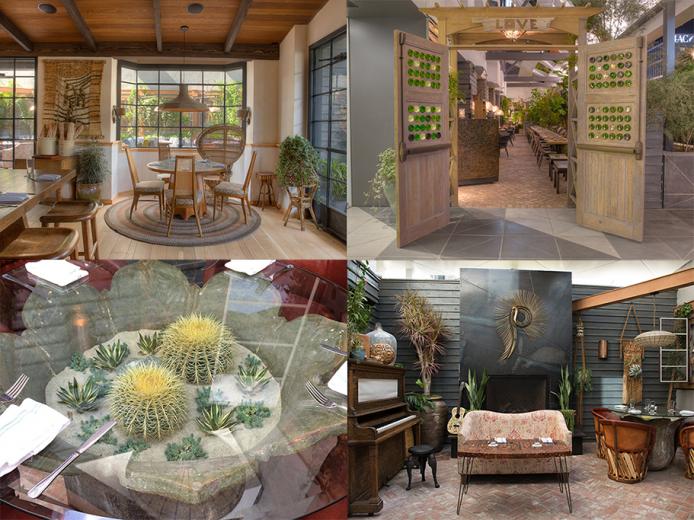1 9
1 9
Choice Hospitality Group and former Top Chef contestant Dakota Weiss tapped Santa Monica, CA, design firm Studio Collective to create a hippie retreat setting for Estrella, their new restaurant on Los Angeles’s Sunset Strip. The 1970s bungalows of nearby Laurel Canyon, where musicians like Mama Cass Elliot, Joni Mitchell and other artists lived and worked, served as the inspiration for Estrella, which was named for a character in Mitchell's song “Ladies of the Canyon.” The restaurant, according to Choice Hospitality, “evokes a time when food, music, artistry and community all coexisted under one canopy.”
Weiss’s eclectic all-day menu includes the “Rolling Stone,” a poached egg in an avocado, wrapped in bacon, baked and served with sliced tomato and queso fresco; green tomato gazpacho with golden balsamic and coriander; and sour orange molasses-rubbed lamb chops with white beans and slow-roasted San Marzano tomatoes.
The majority of the restaurant’s seats are located on an expansive, L-shaped outdoor patio. It is lined with a wood trellis and features colorful glass pendants, twinkling lights and lush plants. An eclectic collection of furnishings and accessories includes vintage finds and custom pieces that come together to create a time-worn, indoor-outdoor feel that evokes the late 1960s and early 1970s.
Studio Collective principles Adam Goldstein and Leslie Kale showed us around.
At the entrance, a custom wood arbor gate was inspired by Laurel Canyon indoor-outdoor lifestyle of the 1960s and '70s. Kale found the “love” sign while perusing a second-hand shop in Solana Beach, CA. The tiny glass windows are wine bottles bottoms. At night, they create a warm, backlit glow. The floor at the entryway is reclaimed brick placed in a herringbone pattern.
Estrella is located on the ground floor of a 12-story office building. “It’s very modern and we wanted to set Estrella apart a little, so we [created] an indoor-outdoor, friendly neighborhood casual place, not something super trendy,” says Goldstein. "The materials used throughout were common in those bungalows of the time and have a warm, natural, organic feel [including] wood floors, ceilings and furniture.”
Behind a bar-height table is custom millwork that displays “little things that we thought were timely,” says Kale. “We collected objects over a course of eight or nine months,” from sources like local vintage stores and Craigslist. Custom hand-painted tiles on the bar face add color and a counterpoint to the warm woods of the bar area, Kale explains.
Didn't everyone's cool aunt have a chair like the one on the right? This dining nook sits in a windowed, hexagonal alcove. “We liked the idea of a breakfast nook here; the one unique chair gives it a very residential feel,” says Goldstein.
A line of planters separates Estrella’s L-shaped patio from Sunset Blvd. All materials are damp- and wet-listed. The custom light was created by a macramé artist Kale found on Etsy, a resource she recommends to anyone looking for unique furnishings. “It’s a great way to find vendors and small fabricators that we’d normally not have access to,” she explains. Most of the chairs at the banquette are from a reused set. Their plain surfaces were covered in clippings of from old magazines like Rolling Stone, as well as pieces of wallpaper in a tie-dye pattern. An artist subcontractor applied them with a decoupage technique.
Greenery and window boxes filled with accessories decorate a second garden seating area. Teak tables and outdoor fabrics provide functionality.
The theme of a musician’s residence is carried over to an outdoor lounge space with a piano found on Craigslist and thrift shop accessories. The antique guitar was an eBay find. “There’s a fine line between [evoking a] particular period and Sanford and Son” jokes Goldstein. The secret is to “have a vision early on and to curate and edit as you go,” adds Kale. The table, right, is a glass-topped planter. A cactus garden lives under the glass.
The cactus table is a glass-topped planter.

